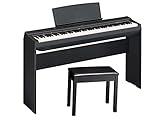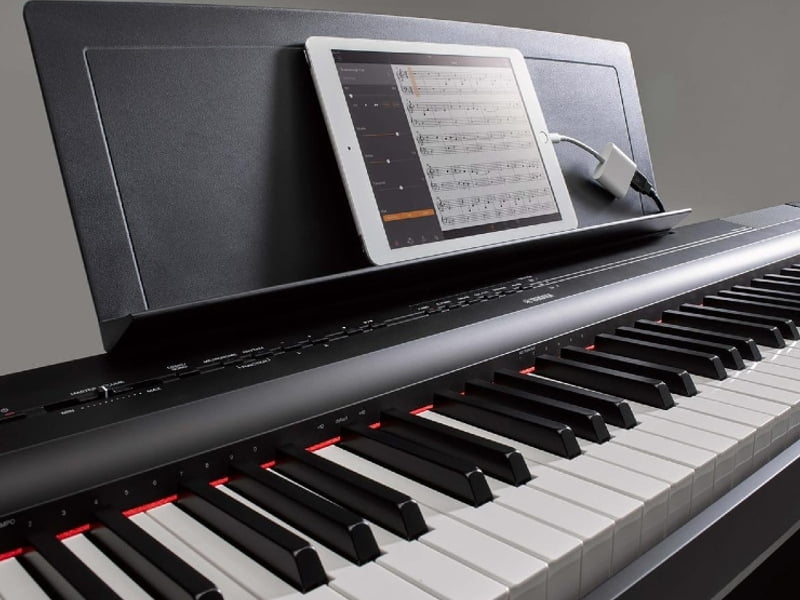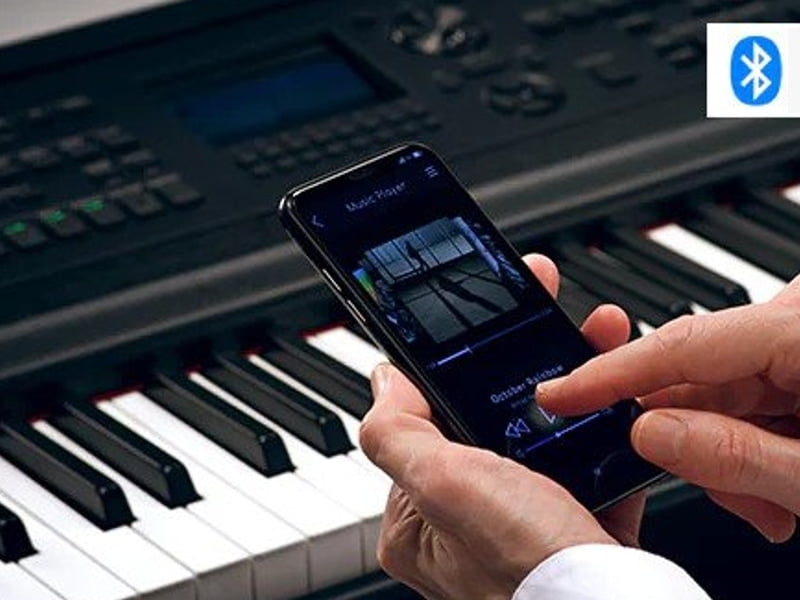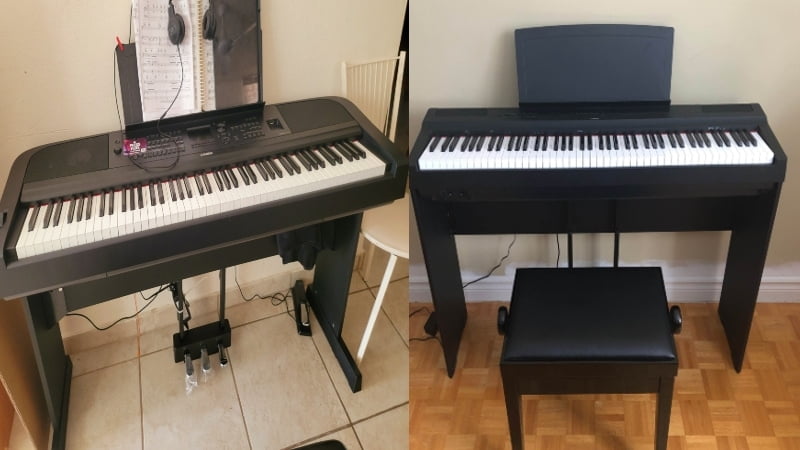Find out which Yamaha piano is the better option in this Yamaha P125 vs DGX 670 review.
Two digital pianos that caught my eye the last time I went shopping were the Yamaha P125 and the DGX 670. These are two very different pianos, but since they’re in the same relative price range, I couldn’t help but compare the two.
And after much consideration and testing, I found that the Yamaha DGX-670 offers more value for the money. This piano has more voices, comes with more features, and is a bit cheaper than the P-125, making for a great arranger piano.
But even if I would recommend the P-125, I’m not going to say that the P-125 doesn’t come with cool features. For its price, this is a really good portable digital piano with rich Yamaha tones and a realistic feel.
So, how do these pianos stack up against each other in a head-to-head comparison?
Well, the battle was pretty close, and I’ll get into the details in this Yamaha P-125 vs DGX-670 review. And by the end, you’ll know exactly which piano will fit your needs the best.
Yamaha P125 vs DGX 670: Comparison Chart




Last update on 2025-07-10 / Affiliate links / Images from Amazon Product Advertising API
Yamaha P125 vs DGX 670: A Head-to-Head Comparison
These pianos have many differences, which is why comparing the two was a lot of fun. I decided to compare the pianos based on their differences to get as objective a winner as possible. And by the end of the comparison, the score was 3-1 in favor of the DGX-670.
While the DGX-670 took the point in almost every category, it was still a pretty close fight. Keep reading to learn the details of how the Yamaha DGX-670 beat out the P-125 and why I chose the DGX-670 as the winner.
Feel
The winner: DGX-670
Feel is arguably the most important feature of a digital piano. A digital piano is only worth buying if it can replicate the feel and weight of playing an acoustic piano. And when testing out both models, I found that they do a great job at replicating the subtle weight difference you’re used to in acoustic pianos.
However, I did have a slight issue with the actual texture on the P-125 keys. And since the DGX-670 does a better job in terms of key texture, it ended up with the point in this comparison.
+Hammer Action
To start, we need to discuss the hammer action on both of these pianos. One of the best features of both instruments is that they come with Yamaha’s Graded Hammer Standard or GHS system. This is an advanced hammer action system designed to perfectly replicate the slight weight differences on the keys of an acoustic piano.
If you’ve played acoustic pianos before, you probably know that the weight isn’t uniform. Instead, the lower keys have a slightly heavier action than the higher keys. Most digital pianos don’t do anything to address this, but the P-125 and DGX-670 are different.
When I tried out both of these pianos, I was delighted by the weight of the keys. Both of the pianos do a great job of emulating the weight of an acoustic piano. And between the two, I could barely tell the difference in weight.
However, I have to note that the P-125 felt a bit more digital than the DGX-670, but not because of the weight. Instead, I noticed that the texture of the P-125 keys is very far from that of a real wooden piano. And that’s exactly what I’m getting into in the next section.
+Key Texture

If I were to judge both pianos solely by the weight of the keys, both of them would take the point. However, I also had to account for key texture, and in this category, the DGX-670 is the clear winner.
When I played the P-125, I noticed it had glossy plastic keys. This means that the keys feel a bit slippery, and the texture is far from what you’d expect on an acoustic piano.
On the flip side, the DGX-670 has a matte coating on the plastic keys. Granted, the keys still have a slight plastic feel to them. But since it has a matte coating, the keys do a better job of replicating the feel of an acoustic piano, which is why I ended up giving the point to the DGX-670.
Tone
The winner: Yamaha DGX-670
The second comparison point I had with these two pianos was the tone. After all, the way a digital piano sounds is probably the most important feature to consider for many pianists. And in this category, the DGX-670 came out on top again.
Since the DGX-670 is an arranger piano, you can expect many tones, voices, and songs from the piano. The P-125, on the other hand, is a more traditional digital piano, so it has a smaller variety of voices.
And while they both produced high-quality and rich tones, the DGX-670 had a definite edge because of its varied sound library.
+Tone Generator
These pianos use different tone generators. The Yamaha P-125 has the Pure CF Sound engine, while the Yamaha DGX-670 uses the CFX engine. Both tone generators come from Yamaha, though the CFX is the newer generator from Yamaha.
These tone generators use samples you trigger whenever you press a key. On top of that, both pianos recorded their piano tones from Yamaha’s CF Grand Piano, which is renowned for its incredible sound quality and clarity.
So, one of the benefits you can get from both pianos is top-tier piano tones that rival digital pianos in higher price ranges. That said, the CFX engine is a bit newer, so the quality of the tones is a bit higher on the DGX-670.

+Sound Library
When I compared the sound quality of both pianos, it was a pretty close fight. But when I compared the sound libraries, there was no doubt in my mind that the DGX-670 was the winner.
The DGX-670 is an arranger piano, so it’s designed to be a workhorse. That’s why you can find over 600 different voices on the piano. This includes classic tones like acoustic and electric pianos and more experimental tones like synths, basses, strings, and even sound effects!
On top of that, the DGX-670 comes with pre-loaded songs that you can play along with to jam or when performing. That way, you can have a fuller sound on stage without hiring a whole band to back you up.
The P-125 only comes with 24 tones. And while pales in comparison to the DGX-670’s library, it’s a pretty wide library for a portable digital piano. You can find all the essential piano sounds on the P-125 along with a couple of bass, organ, and strings voices.
Because of this, I found that the P-125 is the better option for beginners as the smaller sound library removes distractions and allows you to focus on developing your piano playing technique. But if you need more flexibility when it comes to the sounds the piano produces, the DGX-670 is the better option.
Piano Features
The winner: Tie
One area where both of these pianos were tied was in the extra piano features. I was happy to see that both pianos came with various playing modes and a very useful set of effects that you can use when practicing or when performing on stage!
+Playing Modes
When you use these pianos, you’ll find that they both have split, duo, and dual modes. And if you’re a piano student or a performer, these are some of the most useful modes you can use to take full control of your sound.
With split mode, you can divide the piano into two keyboards loaded with different voices. So, you can have a bass or strings voice on the left side while keeping a piano or synth voice on the right hand. That way, it seems like you’re playing two instruments at the same time.
When you use dual mode, you can blend two voices together. This is a very useful feature as it allows you to have a fuller or richer sound. For example, if playing the accompaniment for a vocalist, you can blend strings and piano voices to take up more sonic space when playing.
Lastly, duo mode makes piano lessons much easier. This mode divides the piano into two smaller keyboards with the same tone, pitch, and timbre. That way, the teacher and student can play along with each other without worrying about playing different notes.
+Effects
The P-125 has an effects set designed for basic performances and pratice. This is great for beginners at it gives you a chance to truly learn how to manipulate the sound to your needs and preferences.
With the P-125, you get reverb, IAC, damper resonance, and a sound boost. And if you’re a beginner or novice, these are all the effects you need.
On the flip side, the DGX-670 comes with effects for performances. So, aside from IAC, DPS, and an EQ, you also get reverb and chorus effects. This gives you a bit more versatility, but if you’re a beginner, all these effects can actually be a distraction.

Yamaha P125 vs DGX 670: The Similarities
While these are very different pianos, I found that they have a couple of similarities. For example, they are both portable. So, you won’t have to worry that much when you have to take the pianos out to gigs or piano lessons.
Both pianos even come with a cool set of effects. So, even if they aren’t the most expensive pianos on the market, you get a decent amount of tone control when using them.
Additionally, both of the pianos are in the same relative price range. So, they are both great for beginners and novices looking for a high-quality instrument at a fair price.
That said, I still found the DGX-670 to be the more affordable and versatile option. While the P-125 is great for beginners, there are many pianists that will prefer using the DGX-670 because of its versatility and wide feature set.
Quick Rundown of the Yamaha P125
- Includes P125B digital piano, L125B furniture stand, BB1 wooden bench
- A fully weighted digital piano with 88 full sized piano style keys
- GHS weighted action is heavier in the low keys and lighter in the high keys, just like an acoustic piano
- The pure CF sound engine faithfully reproduces the tone of the acclaimed Yamaha 9' CFIIIS Concert Grand piano
- USB to host connectivity with MIDI and audio transfer means you only need 1 Cable to connect to your music making software
Last update on 2025-07-10 / Affiliate links / Images from Amazon Product Advertising API
Quick Rundown of the Yamaha DGX 670
- CFX Stereo Sampling faithfully reproduces the sound of Yamaha's flagship CFX Full Concert Grand.
- GHS weighted action is heavier in the low keys and lighter in the high keys, just like an acoustic piano. The special matte black key tops are designed to absorb moisture and remain tactile after extended use without becoming slippery.
- Adaptive Style automatically shifts between the Main Style Variations by changing your velocity and number of notes played.
- Unison and Accent function adds a doubled voice to your melody line and musical "hits" when you accent your notes.
- Smart Chord lets you play great-sounding chords from simple Pop triads to complex jazz 7th chords with just a few fingers.
Last update on 2025-07-10 / Affiliate links / Images from Amazon Product Advertising API
Product Videos
Related Articles to Yamaha P125
- Yamaha P150 vs P125: The Battle of the P-Series Models
- Yamaha P125 vs CLP 625: Can a Beginner’s Digital Piano Match the Clavinova?
- Yamaha P125 vs Roland FP 60: Which is the Better Investment?
- Yamaha P-121 vs P-125: Finding the Best Portable Yamaha Piano
- Yamaha P125 vs Korg LP 380: Which Piano Is Better for Your Needs?
- Yamaha P125 vs P85: Can the Outdated Digital Piano Beat the Newer One?
- Yamaha P125 vs Korg SP 280: Which is the Better Beginner’s Digital Piano?
- Yamaha P-255 vs P-125: Finding the Better Option for Beginners
- Yamaha P125 vs YDP S34 Comparison: Does the Portable P125 Hold Up Against a Console Digital Piano?
- Yamaha P125 Vs YDP 164: Should You Get A Console Or Digital Piano?
- Yamaha YDP 103 Vs P125: Should You Get a Portable or Console Digital Piano?
- Yamaha P125 Vs Kawai ES110 Comparison: Which Is The Best Portable Digital Piano
- Yamaha P125 vs Casio PX S1000: Which Digital Piano Is Worth Your Money?
- Casio PX-870 Vs Yamaha P-125: Should You Get A Portable Or Console Digital Piano?
- Alesis Recital Vs Yamaha P125: Which Is The Right Pick For You?
- Yamaha P45 VS P115: Which P-Series Newbie Gives You More Value for Money?
- Alesis Recital Pro vs Yamaha P125 Comparison: Which Is The Best Portable Digital Piano?
- Alesis Prestige Artist vs Yamaha P125 Comparison: Why the Yamaha P125 Is the Better Investment
- Yamaha P125 vs Casio PX-770 Review: Why the Yamaha P125 Beats Out the Casio Console Digital Piano
- Yamaha P125 vs DGX 660 Comparison: Can the P125 Hold Its Own Against the DGX 660?
- Yamaha P125 vs Roland FP-30X Review: Why the Roland FP-30X Comes Out On Top
- Yamaha P125 vs P515 Review: Why the Yamaha P515 Is the Better Investment
- Yamaha P115 vs P125 Review: Can the P125 Beat Out Its Predecessor?
- Yamaha P125 vs Roland FP30: A Close Battle Between Two Great Digital Pianos
- Yamaha P45 vs P125: Why the Yamaha P125 Is the Better Pick for Pianists
- Yamaha P71 vs P125: Why the Yamaha P125 Is the Better Investment
Related Articles to Yamaha Dgx 670
- Yamaha DGX-670 vs YDP 144: Finding the Best Digital Piano
- Yamaha DGX 670 vs Casio PX S3000: Which Piano Comes Out on Top?
- Yamaha DGX 670 vs Roland FP 60x: Which Piano Comes Out on Top?
- Yamaha DGX 670 Vs P515: Which Gives You Bang For Your Buck?
- Yamaha DGX 670 Vs 660: The Distinct Difference In Details You Need To Know About
- Yamaha DGX 670 Vs Roland FP 30x: Which Works Better For Your Needs?
References:
- Yamaha P125: https://usa.yamaha.com/products/musical_instruments/pianos/p_series/p-125/specs.html#product-tabs
- Yamaha DGX 670: https://www.sweetwater.com/store/detail/DGX670BK–yamaha-dgx670b-88-key-black-portable-grand-includes-pa150-power-adapter-and-sustain-pedal-black
Lulacruza is an electronic folk duo operating at the junction of the hypermodern and the ancient. Our music weaves together hypnotic female singing, South American folk instruments and electronic processing, while channeling pulsating waves from the source of creation.
Lalucruza is also a community where you can connect with other music lovers to collaborate, exchange ideas and share knowledge. A platform for who wants to learns the basics of playing piano, guitar, drum masters’ technique, etc.. is the premise of our website.
